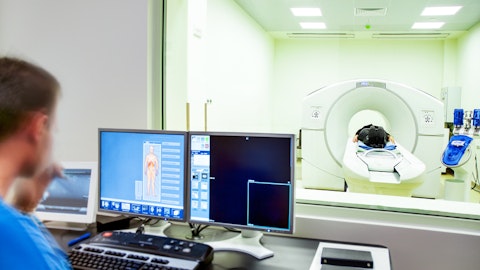In this article, we will be covering the top 20 most profitable pharmaceutical companies in the world. If you wish to see the top ones, head straight to the Top 5 Most Profitable Pharmaceutical Companies In The World.
Undoubtedly, the pharmaceutical industry stands as one of the most financially rewarding and essential sectors worldwide, leading the way in medical advancements and contributing to global health improvements. Within this expansive field, specific companies like Pfizer Inc. (NYSE:PFE), which is the world’s top pharma company, have emerged as influential forces, consistently generating significant profits and transforming the healthcare landscape. You can also explore some of the most profitable drugs in the world manufactured by these companies.
According to recent financial statistics, the top pharmaceutical companies in the world include Johnson & Johnson, Pfizer, and Roche, each generating over $50 billion in revenue annually. These industry leaders have achieved their positions by developing breakthrough medications, leveraging cutting-edge research, and investing heavily in innovation and development. With the ongoing demand for effective and safe medical treatments, the future of these companies looks brighter than ever.
Key Factors Influencing Profitability in the Pharmaceutical Industry
The pharmaceutical industry is a highly competitive and lucrative field that requires careful consideration of several key factors to ensure profitability and success. These factors include research and development costs, patent protection, regulatory compliance, pricing strategies, and market demand. Effective management of these factors can lead to increased profits and sustained growth for pharmaceutical companies while failing to address them can result in financial losses and decreased market share.
According to recent financial statistics, the global pharmaceutical market was valued at $1250.24 billion in 2021 and is expected to reach $1700.97 billion by 2025, growing at a CAGR of 8%. Research and development costs account for a significant portion of a pharmaceutical company’s expenses, with an estimated average price of $2.6 billion per drug. The United States is the no. 1 country in the pharma industry, with Pfizer Inc. (NYSE:PFE) and Johnson & Johnson being the largest pharma companies in the US. The US accounts for approximately 41% of global pharmaceutical spending in 2021. China emerged as the second-largest market, capturing nearly 12% market share.
Additionally, patent protection plays a crucial role in the industry, with a typical patent lasting 20 years from the date of application. Regulatory compliance is also essential for pharmaceutical companies, as non-compliance can result in costly fines and legal action. Pricing strategies must be carefully considered to balance profitability with affordability for patients.
Finally, understanding market demand and adapting to changing trends is crucial for sustained growth and success. By effectively managing these key factors, pharmaceutical companies can increase profits and maintain a strong market position in this highly competitive industry.
Global Market Dynamics and Competitive Landscape in the Pharmaceutical Industry
The global pharmaceutical industry is constantly evolving and facing new challenges as companies strive to stay ahead of the competition. Market dynamics play a significant role in shaping the industry, with factors such as changing regulations, emerging technologies, and shifting consumer preferences all impacting. In 2022, the global pharmaceutical industry generated $1.48 trillion in revenue.
One of the biggest challenges facing pharmaceutical companies today is the rising cost of research and development. As new technologies emerge and regulatory requirements become more stringent, companies are investing more time and money in developing new drugs, driving up healthcare costs and putting pressure on pharmaceutical companies to find new ways to innovate and stay competitive. In 2019, the top pharmaceutical companies spent $83 billion on research and development.
The growing demand for personalized medicine is another critical factor shaping the pharmaceutical industry. Consumers are increasingly looking for treatments tailored to their individual needs and genetic makeup, which is driving companies to invest in new research and development strategies. In 2021, the global personalized medicine market was valued at $2.12 trillion and is expected to reach $5.7 trillion by 2030, as noted by Precedence Research.
At the same time, competition in the pharmaceutical industry is fierce, with companies vying for market share and trying to outdo each other in terms of innovation and pricing, leading to a highly competitive landscape, with companies constantly looking for ways to gain an edge over their rivals.
Despite these challenges, the pharmaceutical industry remains an important and highly profitable sector of the global economy. With the right strategies and a strong focus on innovation, companies can continue to thrive in this dynamic and ever-changing market.
Emerging Trends and Future Outlook for Profitable Pharmaceutical Companies
The pharmaceutical industry is experiencing significant trends reshaping its landscape and profitability. Personalized medicine, which tailors treatments to individuals based on their genetics, is a key trend driving innovation but requires substantial investment in research and development. Specialty drugs for rare or complex conditions are also gaining prominence, offering higher profit potential for successful market entry.
Looking ahead, technologies like artificial intelligence, machine learning, and 3D printing are promising for identifying new drug targets, developing more effective treatments, and revolutionizing drug manufacturing. Staying abreast of these emerging trends is vital for pharmaceutical companies to maintain profitability in a rapidly evolving industry.

kurhan / shutterstock.com
Our Methodology
For our methodology, we have ranked the top most profitable pharmaceutical companies in ascending order of high profit-revenue ratios as of 2022.
Here is our list of the top most profitable pharmaceutical companies in the world:
20. Takeda Pharmaceutical Company Limited (NYSE:TAK)
2022 Net Income: $2.04 billion
2022 Revenue: $31.76 billion
Takeda Pharmaceutical Company Limited (NYSE:TAK) experienced a successful year in 2022, with a 13.7% increase in revenues. The company achieved global approvals for its dengue fever vaccine, Qdenga, and made substantial investments in manufacturing. Takeda’s portfolio of plasma therapies grew by 18%, and it successfully launched Livtencity and Exkivity while expanding the market presence of brands like Entyvio and Alunbrig.
In 2023, Takeda Pharmaceutical Company Limited (NYSE:TAK) anticipates facing generic competition for Vyvanse and Gattex but expects its gastrointestinal products to offset the impact. Notably, Entyvio demonstrated significant growth on its own.
19. AstraZeneca PLC (NASDAQ:AZN)
2022 Net Income: $3.28 billion
2022 Revenue: $44.35 billion
AstraZeneca PLC (NASDAQ:AZN) achieved record-breaking annual revenue of $44.35 billion in 2022, driven by the successful integration of Alexion. SGLT2 inhibitor Farxiga and oncology drugs like Tagrisso and Imfinzi fueled the company’s growth. A significant focus for AstraZeneca PLC (NASDAQ:AZN) is antibody-drug conjugates, with Enhertu leading the way. However, China’s sales declined due to price reductions.
18. Bayer
2022 Net Income: $4.92 billion
2022 Revenue: $53.67 billion
Bayer is transitioning with a new CEO and a changing pharma portfolio. Blockbusters like Xarelto are facing a decline, while new products like Nubeqa show promise in prostate cancer treatment. Sales of Eylea have shown a slowdown, and pricing challenges are expected to persist. Other products, including Stivarga and Gadovist, have experienced double-digit sales increases. Bayer is also focusing on pipeline drugs such as asundexian and elinzanetant.
17. Novartis AG (NYSE:NVS)
2022 Net Income: $6.95 billion
2022 Revenue: $50.5 billion
Novartis AG (NYSE:NVS) initiated a significant restructuring in 2022, consolidating its oncology and therapeutic areas and adopting a U.S.-focused strategy. The company aimed to achieve annual savings of $1.5 billion through job cuts and operational streamlining. Both the Sandoz and Innovative Medicines divisions experienced 4% growth.
Novartis AG (NYSE:NVS) aspires to establish itself as a top-five U.S. drugmaker. Sales growth was observed for Entresto, Kesimpta, and Kisqali, while Zolgensma faced a decline. Leqvio had a slow uptake, Pluvicto encountered supply challenges, and Tislelizumab experienced FDA delays. Notably, Iptacopan met phase 3 goals in clinical trials for paroxysmal nocturnal hemoglobinuria.
16. Bristol-Myers Squibb Company (NYSE:BMY)
2022 Net Income: $6.33 billion
2022 Revenue: $46.2 billion
Bristol-Myers Squibb Company (NYSE:BMY) experienced a slight decline in sales in 2022 (-0.5%) after a 9% increase in 2021. The loss of exclusivity for Revlimid led to a 22% drop in sales. However, BMS predicts a 2% overall revenue increase, with solid performances expected from Eliquis and Opdivo. BMS also has three promising new products approved in 2022.
In addition to its megablockbusters, Bristol-Meyers Squibb Company (NYSE:BMY) has several drugs with sales of over $2 billion and more unique medicines like Reblozyl, Onureg, and Zeposia showing significant growth. Gene therapies Abecma and Breyanzi had successful first-year sales.
15. Merck KGaA
2022 Net Income: $3.50 billion
2022 Revenue: $23.38 billion
Merck KGaA exceeded expectations in 2022 despite the warning of volatility. The company’s revenue reached approximately $23.38 billion in 2022. Merck KGaA’s solid performance includes its electronics arm, accounting for 18% of sales. The company strengthened its CDMO capabilities by launching the Life Sciences Services division and expanding its facilities. Notable expansions took place in Ireland and Wisconsin, with plans for job creation. Merck KGaA also partnered, such as supporting Lotte’s U.S. biologics business.
14. Gilead Sciences, Inc. (NASDAQ:GILD)
2022 Net Income: $4.6 billion
2022 Revenue: $27.28 billion
Gilead Sciences, Inc. (NASDAQ:GILD) had a flat year in 2022 but still maintained a strong position in the top 20 list. While sales from the COVID-19 treatment Veklury started to decline, the company relied on its HIV portfolio and new growth products. Biktarvy, a combination pill for HIV, reached $10.4 billion in sales, and the company unveiled data showing its effectiveness against HIV and hepatitis B co-infection. Oncology products Trodelvy, Yescarta, and Tecartus also contributed to sales growth.
Gilead Science, Inc. (NASDAQ:GILD) aims to generate a third of its revenue from oncology products by 2030. Veklury sales decreased as demand for COVID-19 products slowed, but the company sees it as a sustainable business due to its clearance for use in hospitalized patients.
13. Sanofi (NASDAQ:SNY)
2022 Net Income: $8.82 billion
2022 Revenue: $47.82 billion
Under the leadership of CEO Paul Hudson, Sanofi (NASDAQ:SNY) experienced 7% sales growth in 2022, primarily driven by the success of Dupixent and the vaccine franchise. Dupixent generated significant revenue of 8.3 billion euros ($9.75 billion), with expectations to reach 10 billion euros ($11.68 billion) in 2023. Despite some business development and pipeline setbacks, Sanofi (NASDAQ:SNY) has key launches underway, including Beyfortus for RSV prevention and Altuviiio for hemophilia A treatment.
12. Johnson & Johnson (NYSE:JNJ)
2022 Net Income: $17.94 billion
2022 Revenue: $94.94 billion
In 2022, Johnson & Johnson (NYSE:JNJ) ranked second in global sales, following Pfizer. The company reported revenues of $94.9 billion, with its pharmaceutical business generating $52.56 billion. Key contributors to the pharma business’s growth were drugs such as Darzalex, Stelara, and Erleada. However, J&J also faced sales declines for Remicade and Imbruvica, primarily due to biosimilar competition.
Johnson & Johnson (NYSE:JNJ)’s medical devices group earned $27.43 billion, and the consumer healthcare unit contributed $14.95 billion. J&J faces a challenge with upcoming biosimilars for Stelara but expects to reach $60 billion in global pharma sales by 2025. The company is also spinning its consumer group into a standalone entity called Kenvue.
11. Roche
2022 Net Income: $13.01 billion
2022 Revenue: $66.26 billion
In 2022, Roche faced biosimilar competition, declining COVID-19 sales, and pipeline setbacks. Biosimilars impacted revenue from cancer drugs, resulting in a 1.9 billion Swiss francs ($2 billion) loss. COVID-19-related sales also declined, and Roche expects a significant sales decrease of about 5 billion Swiss francs ($5.47 billion). Despite challenges, drugs like Ocrevus, Hemlibra, and Tecentriq grew but faced competition. Roche introduced new treatments but had unsuccessful clinical programs. The company underwent a leadership transition with Thomas Schinecker as the new CEO.
10. AbbVie Inc. (NYSE:ABBV)
2022 Net Income: $11.83 billion
2022 Revenue: $58.95 billion
AbbVie Inc. (NYSE:ABBV), an Illinois-based drug company, is facing challenges as its top-selling drug, Humira, loses market exclusivity in the U.S. The company is banking on its immunology drugs, Skyrizi and Rinvoq, to surpass Humira’s sales. In 2022, Skyrizi and Rinvoq generated $7.69 billion in sales, while Humira brought in $21.24 billion despite biosimilar competition in Europe.
AbbVie Inc. (NYSE:ABBV) expects price concessions to impact Humira in 2023, potentially leading to volume losses. Competition from BeiGene’s Brukinsa caused a 16% decline in sales for AbbVie’s Imbruvica. To address these changes, AbbVie may pursue more mergers and acquisitions. Aesthetics and neuroscience drugs in AbbVie’s portfolio saw moderate sales growth in 2022.
9. Eli Lilly and Company (NYSE:LLY)
2022 Net Income: $6.24 billion
2022 Revenue: $28.55 billion
In 2022, Eli Lilly and Company (NYSE:LLY) experienced a transition with declining revenues from COVID-19 antibodies but growth in critical drugs. Top-selling Trulicity, a Type 2 diabetes drug, grew by 15%, while Verzenio, a cancer drug, saw an 84% increase. However, revenues from top insulins and COVID-19 antibodies declined. The company has plans to launch new drugs in 2023, including donanemab for Alzheimer’s, pirtobrutinib for mantel cell lymphoma, mirikizumab for ulcerative colitis, and lebrikizumab for atopic dermatitis.
A setback occurred when the FDA required a traditional approval process for donanemab. Eli Lilly and Company (NYSE:LLY) also pledged to lower insulin prices in the U.S. and implemented a program to cap out-of-pocket costs.
8. Amgen Inc. (NASDAQ:AMGN)
2022 Net Income: $6.6 billion
2022 Revenue: $26.32 billion
Amgen Inc. (NASDAQ:AMGN) experienced slow growth in 2022 but is anticipated to improve its performance through the acquisition of Horizon Therapeutics and the launch of its Humira biosimilar. While Lumakras sales declined and Mvasi and Kanjinti faced competition and price pressures, Amjevita, the Humira biosimilar, has obtained approval in Europe and holds a competitive advantage in the U.S. market.
Nplate sales saw an increase due to a significant order from the U.S. Department of Health and Human Services. Amgen Inc. (NASDAQ:AMGN) acquired Horizon Therapeutics for approximately $28 billion, expanding its portfolio with drugs such as Krystexxa, Tepezza, and Uplizna.
7. Merck & Co., Inc. (NYSE:MRK)
2022 Net Income: $14.52
2022 Revenue: $59.3 billion
Merck & Co., Inc. (NYSE:MRK), known for its vaccines, faced setbacks in COVID-19 vaccine development but found success with the oral antiviral treatment Lagevrio, generating $5.68 billion in 2022. However, Lagevrio recently failed a trial and received a negative assessment from Europe’s drug regulator. Keytruda, Merck & Co., Inc (NYSE:MRK)’s bell cow drug contributed to a 22% revenue increase in 2022 with sales of $20.9 billion.
Sales of diabetes treatments, including Januvia, declined by 15% to $4.5 billion due to contaminant concerns. Gardasil sales reached $6.9 billion, driven by higher demand in China. Other blockbusters, such as Varivax, Bridion, Lynparza, and Lenvima, also grew sales.
6. Biogen Inc. (NASDAQ:BIIB)
2022 Net Income: $3.04 billion
2022 Revenue: $10.1 billion
Biogen Inc. (NASDAQ:BIIB), a leading biopharmaceutical company, reported impressive financial results in 2022. With a net income of $3.04 billion and revenue totaling $10.1 billion, Biogen, Inc. (NASDAQ:BIIB) showcased its strong performance in the market. The company’s focus on developing innovative therapies and treatments has contributed to its financial success. Biogen, Inc. (NASDAQ:BIIB) continues to make significant strides in the biopharmaceutical industry, driven by its commitment to improving patient outcomes and addressing unmet medical needs.
Click to see and continue reading the Top 5 Most Profitable Pharmaceutical Companies In The World.
Suggested Articles:
- 11 Best Health Insurance Stocks to Buy.
- 15 Best Healthcare Stocks To Buy Now.
- 10 Dementia Medications that are Approved or in Clinical Trials.
Disclosure. None: The Top 20 Most Profitable Pharmaceutical Companies In The World is originally published on Insider Monkey.





